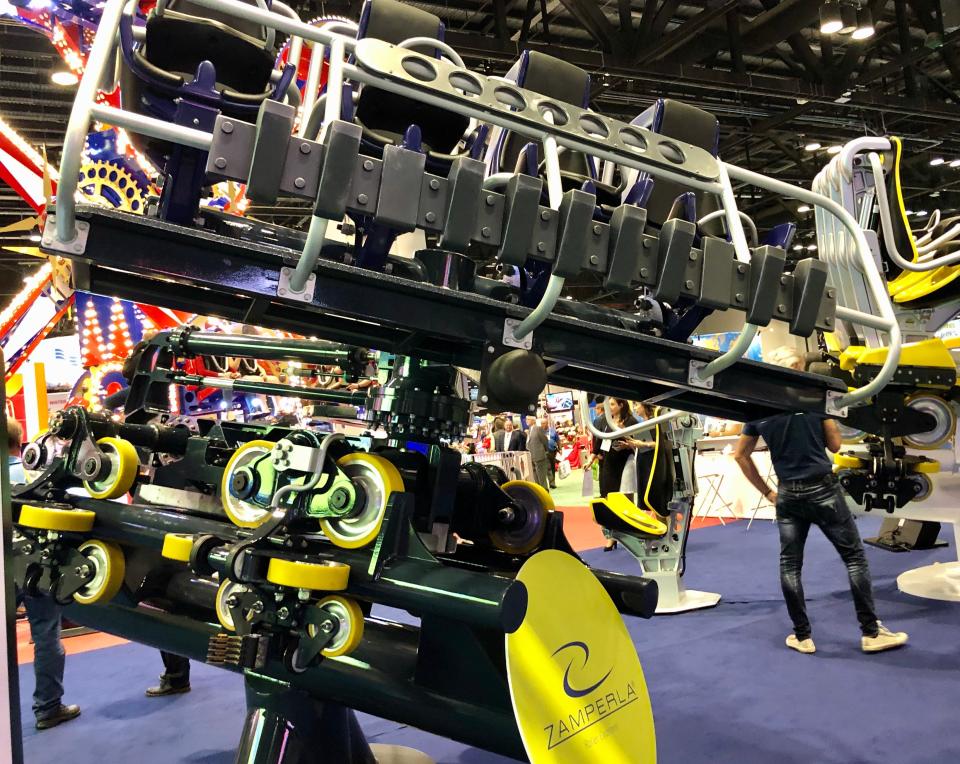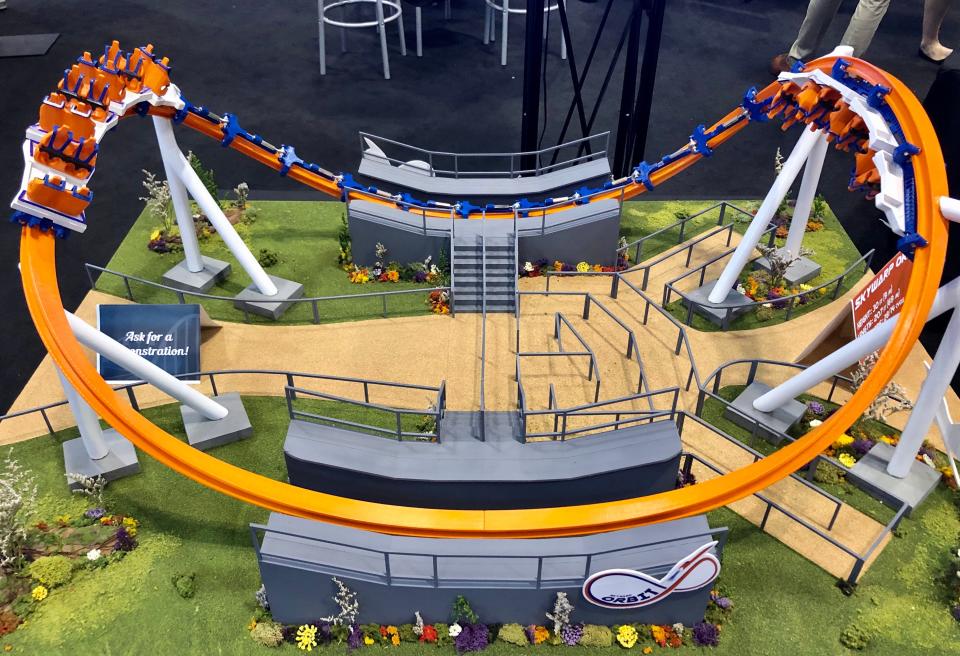IAAPA rides of the future: Roller coaster/waterslide hybrids, flying theaters and more
ORLANDO, Fla. – The annual IAAPA Expo, which brings attraction designers, ride manufacturers and other industry professionals together from around the world, is being held this week in the theme park capital of the world. By putting their latest innovations, cutting-edge technology and wild, creative concepts on display at the trade show, companies hope to pique the interest of parks and attractions.
The Expo offers something of a crystal ball into the industry. The newfangled roller coasters, dark (indoor) rides and other attractions featured on the trade show floor may show up on park midways down the road. Among more than 1,100 exhibitors in attendance, it can be difficult to gauge what will gain traction, but the following are some of the more compelling developments I discovered at the Expo.
2020 theme park sneak peek: SeaWorld, Busch Gardens, Silver Dollar City show off new rides
As has been the case for a number of years, concepts that incorporate virtual reality are everywhere at the trade show. Sub Sea Systems has a particularly unique take on the technology. It uses a combination snorkeling mask and headset to provide an underwater VR experience. Why underwater?
“The neutral buoyancy medium is as close to the zero gravity of space as we can get,” says Jim Mayfield, the company’s president.
It was uncharacteristically cool in Orlando, but I donned a bathing suit and hopped into a portable pool (heated, thank goodness) at the Expo to give two versions of the concept a whirl. For DIVR, a free-floating experience that visitors can try at select locations, I found myself soaring around and through the International Space Station, which was quite captivating.
Even more intriguing was a just-announced system, DIVR+, that uses a thruster mechanism onto which guests grab to simulate a diver propulsion vehicle. It vibrates and emits jets of water to enhance the sensation of taking an underwater journey. By literally placing guests underwater, Sub Sea Systems redefines the meaning of an immersive VR experience.
You might think there wouldn’t be ways left to tinker with the design of roller coasters, rides that have thrilled park visitors for more than 100 years. You’d be wrong. Exhibitors are presenting some fascinating innovations at the Expo.
Ride company S&S is pitching its Axis coaster. It features seats that are raised above the vehicle’s chassis and attached to a cam that allows them to pivot and send passengers rotating independently of the train. The coaster could, for example, flip riders upside down even when the train itself is right-side up.
“Passengers won’t know where they are going,” says Preston Perkes, executive director of administration for S&S. “It’s coaster dynamics reinvented.”
Likewise, Italian ride manufacturer Zamperla is redefining coaster dynamics with its DangleZ coaster, which it introduced at the Expo. It, too, features seats that move independently from the chassis, but instead of rotating around, they are designed to drift either left or right 80 degrees.
“We are breaking the plane of the track’s verticality,” says Michael Coleman, Zamperla’s North American sales manager.

At its booth, Skyline Attractions included a model of Orbit, the latest iteration of its compact, single-train Skywarp coaster series. The 30-foot-tall ride, which is designed to send passengers around an oval track multiple times, includes an inversion and gives the illusion of two racing trains.

“What comes out when a roller coaster and a waterslide have a baby?” asks Frank Heimes, a consultant with German ride manufacturer Wiegand Waterrides. “The Slide Coaster,” he says as he demonstrates how the prototype hybrid attraction that he designed works. Using a coaster-style magnetic launch system, a catch car with two arms propels two waterslide rafts uphill at speeds reaching 31 mph. “This ride can have the acceleration – and exhilaration – of coasters that’s never been experienced on a waterslide,” Heimes says.

Two companies announced dark ride vehicles at the Expo. (Dark rides are attractions, such as Disney’s Haunted Mansion, that move passengers in vehicles through indoor, themed environments.) Cavu Designwerks introduced the Self Driving Vehicle, which includes laser navigation and intelligent pathfinding technology to chart its own way through show scenes in real time.
Its designers say that among its possible applications, the vehicle could integrate with live actors and autonomously navigate around them or respond to passengers’ cues to choose how they would want the experience to unfold.
Simworx unveiled its own trackless attraction concept, the AGV (Automated Guidance Vehicle). Among its attributes, the vehicles are capable of speeds three times faster than other trackless vehicles and can synchronize with projected media to provide a motion simulator experience (à la Universal’s Spider-Man attraction) thanks to the motion base on which they are mounted.
Matt Clarkson, lead designer at Simworx, says multiple vehicles could be programmed to spin and come barreling at one another to tease near collisions.

Many themed entertainment companies design flying theater attractions (think Disney’s Soarin’). Simtec revealed the next generation of its system, HexaFlite 2.0, at the Expo.
The attraction’s seats can deliver six degrees of freedom to offer more motion fluidity than other flying theaters, according to Andreas Stickel, the company’s business development director. They also can offer a pre-show by incorporating motion in the loading position and using a ceiling-mounted screen to, say, simulate a rocket blastoff. Then the platform can tilt down and into “flying position” in front of the attraction’s main, wraparound screen.
This article originally appeared on USA TODAY: Theme park rides of the future: Hybrid roller coaster/waterslides?

